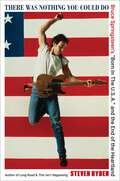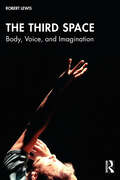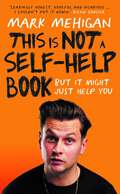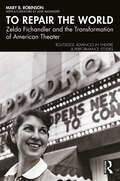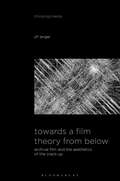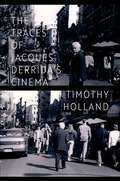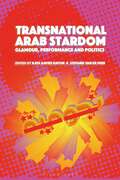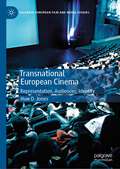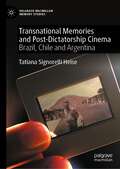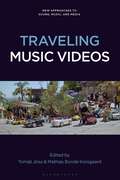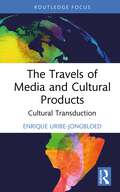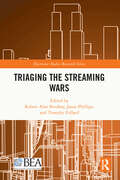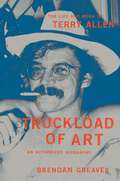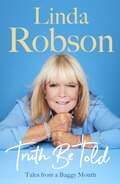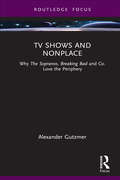- Table View
- List View
The Theological Power of Film (Routledge Studies in Religion and Film)
by James LorenzThis book explores the theological power of film and seeks to render a properly theological account of cinematic art. It considers: What theology and theological practice does cinematic art give rise to? What are the perceptual and affective potentials of film for theology, and what, if anything, is theological about the cinematic medium itself? The author argues that film is a fundamentally embodied art form, a haptic and somatic medium of perception-cum-expression. This, combined with the distinct temporal aesthetic of film, invests cinema with profound theological potentials. The chapters explore these potentials through theological-cinematic analysis, emphasising the themes of encounter, embodiment, time, and contemplation, as well as three intimately connected doctrines of Christian theology: creation, incarnation, and eschatology. Throughout the book, the films and writings of the Russian director Andrei Tarkovsky emerge as a singular illustration of the theological power of film, becoming a crucial resource for theologicalcinematic analysis.
There Was Nothing You Could Do: Bruce Springsteen's “Born In The U.S.A.” and the End of the Heartland
by Steven HydenA thought-provoking exploration of Bruce Springsteen&’s iconic album, Born in the U.S.A.—a record that both chronicled and foreshadowed the changing tides of modern America On June 4, 1984, Columbia Records issued what would become one of the best-selling and most impactful rock albums of all time. An instant classic, Bruce Springsteen&’s Born in the U.S.A. would prove itself to be a landmark not only for the man who made it, but rock music in general and even the larger American culture over the next 40 years. In There Was Nothing You Could Do, veteran rock critic Steven Hyden shows exactly how this record became such a pivotal part of the American tapestry. Alternating between insightful criticism, meticulous journalism, and personal anecdotes, Hyden delves into the songs that made—and didn&’t make—the final cut, including the tracks that wound up on its sister album, 1982&’s Nebraska. He also investigates the myriad reasons why Springsteen ran from and then embraced the success of his most popular (and most misunderstood) LP, as he carefully toed the line between balancing his commercial ambitions and being co-opted by the machine. But the book doesn&’t stop there. Beyond Springsteen&’s own career, Hyden explores the role the album played in a greater historical context, documenting not just where the country was in the tumultuous aftermath of Vietnam and Watergate, but offering a dream of what it might become—and a perceptive forecast of what it turned into decades later. As Springsteen himself reluctantly conceded, many of the working-class middle American progressives Springsteen wrote about in 1984 had turned into resentful and scorned Trump voters by the 2010s. And though it wasn&’t the future he dreamed of, the cautionary warnings tucked within Springsteen&’s heartfelt lyrics prove that the chaotic turmoil of our current moment has been a long time coming. How did we lose Springsteen&’s heartland? And what can listening to this prescient album teach us about the decline of our country? In There Was Nothing You Could Do, Hyden takes readers on a journey to find out.
The Third Space: Body, Voice, and Imagination
by Robert LewisThe Third Space serves a crucial need for contemporary performers by providing an interdisciplinary and physiovocal approach to training. It is a new take on body and voice integration designed to develop the holistic performer. It takes performers through a series of step-by-step practical physiovocal exercises that connects the actor’s centre to the outside world, which increases awareness of self and space. It also develops a deeper connection between spaces within the body and the environment by connecting sound, imagination, and movement.Robert Lewis’s approach is a way of working that unlocks the imagination as well as connecting performers to self, space, and imagination, through voice and body. It conditions, controls, and engages performers by integrating various voice and movement practices.The theories and practice are balanced throughout by: introducing the practical works theoretical underpinnings through research, related work, and case studies of performances; demonstrating a full program of exercises that helps performers get in touch with their centre, their space, and shape both within and outside the body; and exploring the performers physiovocal instrument and its connection with imagination, energies, and dynamics. This book is the result of nearly 20 years of research and practice working with voice and movement practitioners across the globe to develop training that produces performers that are physiovocally ready to work in theatre, screen, and emergent technologies.
The Third Space: Body, Voice, and Imagination
by Robert LewisThe Third Space serves a crucial need for contemporary performers by providing an interdisciplinary and physiovocal approach to training. It is a new take on body and voice integration designed to develop the holistic performer. It takes performers through a series of step-by-step practical physiovocal exercises that connects the actor’s centre to the outside world, which increases awareness of self and space. It also develops a deeper connection between spaces within the body and the environment by connecting sound, imagination, and movement.Robert Lewis’s approach is a way of working that unlocks the imagination as well as connecting performers to self, space, and imagination, through voice and body. It conditions, controls, and engages performers by integrating various voice and movement practices.The theories and practice are balanced throughout by: introducing the practical works theoretical underpinnings through research, related work, and case studies of performances; demonstrating a full program of exercises that helps performers get in touch with their centre, their space, and shape both within and outside the body; and exploring the performers physiovocal instrument and its connection with imagination, energies, and dynamics. This book is the result of nearly 20 years of research and practice working with voice and movement practitioners across the globe to develop training that produces performers that are physiovocally ready to work in theatre, screen, and emergent technologies.
This is Not a Self-Help Book
by Mark MehiganMuch of Mark Mehigan's twenties read like a how-to manual: How to get very drunk without raising people's suspicions you might be an alcoholic. Outwardly successful, inside he was drowning. Nearing 30, he was hurtling towards a nervous breakdown and using payday loans to fund a burgeoning cocaine habit. His only choice was to finally relinquish control and ask for help. In doing so he discovered a life beyond his wildest dreams. This new way of life embraced letting stuff go. Giving things up. He discovered the power of rigorous honesty, how to live without relying on destructive behavioural patterns and the joy of letting people in instead of keeping them out. Mark's story is one of recovery and sobriety. It brilliantly articulates the societal pressures that can leave people feeling isolated and lost, and offers a path to finding your own sense of 'good enough'. Perhaps Mark's story can be the spark that ignites that journey for you, or at the very least a guide on how not to mess up your life. Either way, it's definitely not a self-help book.
To Repair the World: Zelda Fichandler and the Transformation of American Theater (ISSN)
by Mary B. RobinsonThis book is a biography in the form of an oral history about a woman whose founding of Arena Stage in Washington, DC in 1950 shifted live professional theater away from Broadway and inspired the creation of non-profit theaters around the country. Dianne Wiest, James Earl Jones, Stacy Keach, and Jane Alexander, among many others, share their memories of this intrepid pioneering woman during Arena Stage’s early years.As Head of New York University’s Graduate Acting Program for 25 years, Zelda Fichandler also trained a younger generation of gifted actors. Marcia Gay Harden, Rainn Wilson, Mahershala Ali, and other developing actors who became “artist-citizens” under her guidance, talk about the ways in which she transformed their lives.Theater practitioners who have lived during Zelda Fichandler’s time will find this book a fascinating and entertaining read––as will all theater lovers, especially those in Washington, DC. And through this vivid and compelling oral history, students and aspiring artists will come to grasp how the theatrical past can shed essential light on the theater of today and tomorrow.
To Repair the World: Zelda Fichandler and the Transformation of American Theater (ISSN)
by Mary B. RobinsonThis book is a biography in the form of an oral history about a woman whose founding of Arena Stage in Washington, DC in 1950 shifted live professional theater away from Broadway and inspired the creation of non-profit theaters around the country. Dianne Wiest, James Earl Jones, Stacy Keach, and Jane Alexander, among many others, share their memories of this intrepid pioneering woman during Arena Stage’s early years.As Head of New York University’s Graduate Acting Program for 25 years, Zelda Fichandler also trained a younger generation of gifted actors. Marcia Gay Harden, Rainn Wilson, Mahershala Ali, and other developing actors who became “artist-citizens” under her guidance, talk about the ways in which she transformed their lives.Theater practitioners who have lived during Zelda Fichandler’s time will find this book a fascinating and entertaining read––as will all theater lovers, especially those in Washington, DC. And through this vivid and compelling oral history, students and aspiring artists will come to grasp how the theatrical past can shed essential light on the theater of today and tomorrow.
Towards a Film Theory from Below: Archival Film and the Aesthetics of the Crack-Up (Thinking Media)
by Jiri AngerOperating between film theory, media philosophy, archival practice, and audiovisual research, Jiri Anger focuses on the relationship between figuration and materiality in early films, experimental found footage cinema, and video essays. Would it be possible to do film theory from below, through the perspective of moving-image objects, of their multifarious details and facets, however marginal, unintentional, or aleatory they might be? Could we treat scratches, stains, and shakes in archival footage as speculatively and aesthetically generative features? Do these material actors have the capacity to create “weird shapes” within the figurative image that decenter, distort, and transform the existing conceptual and methodological frameworks?Building on his theoretical as well as practical experience with the recently digitized corpus of the first Czech films, created by Jan Kríženecký between 1898 and 1911, the author demonstrates how technological defects and accidents in archival films shape their aesthetic function and our understanding of the materiality of film in the digital age. The specific clashes between the figurative and material spheres are understood through the concept of a “crack-up.” This term, developed by Francis Scott Fitzgerald and theoretically reimagined by Gilles Deleuze, allows us to capture the convoluted relationship between figuration and materiality as inherent to the medium of film, containing negativity and productivity, difference and simultaneity, contingency and fate, at the same time, even within the tiniest cinematic units.
Towards Embodied Performance: Directing and the Art of Composition
by Rachel DicksteinTowards Embodied Performance invites directors and other generative performance makers to experiment with making their own original, visually stunning, sonically immersive, and physically rigorous embodied performance.Through historical context, the author’s 30-plus years of experience, and original interviews with leading theatre artists, this book sets the stage for a new generation of artists building boundary-breaking work. Directors are often categorized into one of only two frameworks: the Stanislavskian director, whose method is based on text analysis and character wants and needs, and the “auteur” director, whose work might focus on visual spectacle at the expense of text or character objectives. This book argues that the director of embodied performance fuses these two approaches, acting as the author of the event. In Part I, readers will explore the core elements of embodied performance – space, time, body, language, and action – through a lens that bridges traditional directing methodology with experimental, devised, collaborative theatre-making. Part II provides examples of this embodied practice by multi-disciplinary artists in visual and sound installation, video and film, dance-theatre, and new music/opera, including such artists as Shirin Neshat, James Turrell, Bill T. Jones, Janet Cardiff, Okwui Okpokwasili, William Kentridge, and Heather Christian. Part III suggests creative prompts and exercises for performance makers to engage the visual, physical, textual, and sonic in compositional storytelling on stage.Towards Embodied Performance is an invaluable resource for theatre directors, devisers, and generative artists at all levels from students to teachers, from early-career to mid-career artists. Directors, actors, choreographers, designers, composers, writers, scholars, and engaged audience members can all use this text to explore collaboratively created performance that invites its audience into the ripest version of the present moment.
Towards Embodied Performance: Directing and the Art of Composition
by Rachel DicksteinTowards Embodied Performance invites directors and other generative performance makers to experiment with making their own original, visually stunning, sonically immersive, and physically rigorous embodied performance.Through historical context, the author’s 30-plus years of experience, and original interviews with leading theatre artists, this book sets the stage for a new generation of artists building boundary-breaking work. Directors are often categorized into one of only two frameworks: the Stanislavskian director, whose method is based on text analysis and character wants and needs, and the “auteur” director, whose work might focus on visual spectacle at the expense of text or character objectives. This book argues that the director of embodied performance fuses these two approaches, acting as the author of the event. In Part I, readers will explore the core elements of embodied performance – space, time, body, language, and action – through a lens that bridges traditional directing methodology with experimental, devised, collaborative theatre-making. Part II provides examples of this embodied practice by multi-disciplinary artists in visual and sound installation, video and film, dance-theatre, and new music/opera, including such artists as Shirin Neshat, James Turrell, Bill T. Jones, Janet Cardiff, Okwui Okpokwasili, William Kentridge, and Heather Christian. Part III suggests creative prompts and exercises for performance makers to engage the visual, physical, textual, and sonic in compositional storytelling on stage.Towards Embodied Performance is an invaluable resource for theatre directors, devisers, and generative artists at all levels from students to teachers, from early-career to mid-career artists. Directors, actors, choreographers, designers, composers, writers, scholars, and engaged audience members can all use this text to explore collaboratively created performance that invites its audience into the ripest version of the present moment.
The Traces of Jacques Derrida's Cinema
by Timothy HollandSituated at the intersection of film and media studies, literary theory, and continental philosophy, The Traces of Jacques Derrida's Cinema provides a trenchant account of the role of cinema in the oeuvre of one of the most influential philosophers of the twentieth century, Jacques Derrida (1930-2004). The book is animated by Derrida's self-confessed passion for the movies, his reluctance to write about film despite the range of his corpus, and the generative encounters arising between his legacy and the field of film and media studies as a result. Given the expanse of its references, interdisciplinarity, and consideration of Derrida's approach to the experience of both spectatorship and the act of being filmed, The Traces of Jacques Derrida's Cinema contributes to the ongoing close analyses of the philosopher's work while also providing a rigorous introduction to deconstruction. Author Timothy Holland interweaves historical and speculative modes of research and writing to articulate the peripheral-yet surprisingly crucial-place of the cinematic medium for Derrida and his philosophical enterprise. The outcome is a meticulously detailed survey of the centers and margins of Derrida's oeuvre that include forays into such terrain as: his notable appearances in films; an unrealized project on cinema and belief that Derrida proposed in a 2001 interview; the correspondences between the strategies of deconstruction and the traditions, homecomings, and wordplay of David Lynch's cinematic media; and the questions wedded to the future of film studies amid the vicissitudes of the modern, virtual university. Ultimately, Holland pursues the thinking activated by the flickering of Derrida's cinema-not only the absence and presence of film in Derrida's professional and personal life, but also the rigor of academic discourse and the pleasures of the movies, ghosts and technology, religious faith and scientific knowledge, and ruination and survival-as a critical chance for reflection.
Transnational Arab Stardom: Glamour, Performance and Politics
by Kaya Davies HayonBuilding on the work of star studies scholars, this collection provides contextual analyses of off-screen representation, as well as close textual analyses of films and star personas, thereby offering an in-depth study of the Arab star as text and context of Arab cinema. Using the tools of audience reception studies, the collection will also look at how stars (of film, stage, screen and new media) are viewed and received in different cultural contexts, both within and outside of the Arabic-speaking world.Arab cinema is often discussed in terms of political representation and independent art film, but rarely in terms of stardom, glamour, performance or masquerade. Aside from a few individual studies on female stardom or aspects of Arab masculinity, no major English-language study on Arab stardom exists, and collections on transnational stars or world cinema also often neglect to include Arab performers. This new book seeks to address this gap by providing the first study dedicated entirely to stardom on the Arab screen.Structured chronologically and thematically, this collection highlights and explores Arab film, screen and music stars through a transnational and interdisciplinary set of contributions that draw on feminist, performance and film theories, media studies, sound studies, material culture, queer star and celebrity studies, and social media studies.
Transnational European Cinema: Representation, Audiences, Identity (Palgrave European Film and Media Studies)
by Huw D. JonesThis book explores how audiences in contemporary Europe engage with films from other European countries. It draws on admissions data, surveys, and focus group discussions from across the continent to explain why viewers are attracted to particular European films, nationalities, and genres, including action-adventures, family films, animations, biopics, period dramas, thrillers, comedies, contemporary drama, and romance. It also examines how these films are financed, produced, and distributed, how they represent Europe and other Europeans, and how they affect audiences. Case-studies range from mainstream movies like Skyfall, Taken, Asterix & Obelix: God Save Britannia, and Sammy’s Adventures: A Turtle’s Tale to more middlebrow and arthouse titles, such as The Lives of Others, Volver, Coco Before Chanel, The Girl with the Dragon Tattoo, Intouchables, The Angels’ Share, Ida, The Hunt, and Blue Is the Warmest Colour. The study shows that watching European films can sometimes improve people’s understandings of other countries and make them feel more European. However, this is limited by the strong preference for Anglo-American action-adventures that offer few insights into the realities of European life. While some popular European arthouse films explore a wider range of nationalities, social issues, and historical events, these mainly appeal to urban-dwelling graduates. They can also sometimes accentuate tensions between Europeans instead of bringing them together. The book discusses what these findings mean for the European film industry, audiovisual policy, and scholarship on transnational and European cinema. It also considers how surveys, focus groups, databases and other methods that go beyond traditional textual analysis can offer new insights into our understanding of film.
Transnational Memories and Post-Dictatorship Cinema: Brazil, Chile and Argentina (Palgrave Macmillan Memory Studies)
by Tatiana Signorelli HeiseThis book investigates the role that cinemas in Brazil, Chile and Argentina have played in reconstructing memories of the most recent military dictatorships. These countries have undergone a distinctive post-dictatorship experience marked by unprecedented debates about human rights violations, the silencing of victims and accountability for state crimes. Meanwhile, politically committed filmmakers have created an extensive body of work addressing the dictatorship and its aftermath. This book employs a transnational and comparative approach to examine the strategies that these filmmakers have used to render visible what has remained hidden, to make reappear what has disappeared, and to reinterpret historical actors and events from a contemporary perspective. Through attention to the specific properties of the medium and the socio-historical context in which films have been made, it describes the different cinematic modes of remembering that emerged in response to wider memory frameworks in South America.
Trauma-Informed Art Activities for Early Childhood: Using Process Art to Repair Trauma and Help Children Thrive
by Anna ReynerWhy Art & Trauma? By making their own choices as they engage in sensory art experiences, children gain confidence, release stress, express emotions, and develop critical-thinking skills. Art offers a unique opportunity for children to safely experiment with the physical world and re-wire their brains to reduce the negative effects of trauma, all while learning to identify as creative thinkers. This highly illustrated and easy-to-use resource supports trauma-informed work with children ages 3-8. It delves into both the theory and practice of therapeutic art and includes 21 original art lessons and 60 art techniques, all presented visually for ease of use. Both text and illustrations demonstrate how to create a safe, non-retraumatizing environment for children to experience safety, connection and calm. Ideal for implementing into classroom environments, including preschools, kindergarten, early primary grades, afterschool programs, child counselling centers and community-based youth programs, this professional resource is perfectly adaptable for a variety of educational and therapeutic contexts.
Traveling Music Videos (New Approaches to Sound, Music, and Media)
by Tomáš Jirsa and Mathias Bonde KorsgaardTraveling Music Videos offers a new interdisciplinary perspective on how contemporary music videos travel across, shape, and transform various media, online platforms, art institutions, and cultural industries worldwide. With the onset of digital technologies and the proliferation of global video-sharing websites at the beginning of the 21st century, music video migrated from TV screens to turn instead to the internet, galleries, concert stages, and social media. As a result, its aesthetics, technological groundings, and politics have been radically transformed. From the kinaesthetic experience of TikTok to the recent reimaginations of maps and navigation tools through music video cartographies, from the ecofeminist voices mediated by live-stream concerts to the transmedia logic of video games and VR, from the videos' role in contemporary art galleries to their political interventions -the chapters map the ways music video is continually reconfiguring itself. The volume tracks music video's audiovisual itineraries across different geographies, maps its transmedia routes, and tackles the cultural impact that it has on our current media ecosystem.
Travelling: On the Path of Joni Mitchell
by null Ann PowersAn Independent Best Non-Fiction Book for 2024 Celebrated music critic Ann Powers explores the life and career of the legendary Joni Mitchell What you are about to read is not a standard account of the life and work of Joni Mitchell. Instead, it’s a tale of long journeying through a life that changed popular music: of a homesick wanderer forging ahead on routes of her invention, and of me on her trail, heading toward the ringing of her voice. One of the most celebrated artists of her generation, Joni Mitchell has inspired countless musicians and writers, while never stopping still herself. In Travelling, celebrated music critic Ann Powers seeks to understand the paradox of Mitchell – at once both elusive and inviting – through her myriad journeys. Drawing on extensive interviews with Mitchell’s peers and deep archival research, Powers takes readers to rural Canada, charts the course of Mitchell’s musical evolution, follows the winding road of Mitchell’s collaborations with other greats and explores the loves that fed her songwriting. Kaleidoscopic in scope and intimate in detail, Travelling is a fresh and fascinating addition to the Joni Mitchell corpus – and one that questions whether an artist can ever truly be known to their fans.
The Travels of Media and Cultural Products: Cultural Transduction (Routledge Studies in Media and Cultural Industries)
by Enrique Uribe-JongbloedThis book presents the Cultural Transduction framework as a conceptual tool to understand the processes that media and cultural products undergo when they cross cultural and national borders. Using a series of examples from pop culture, including films, television series, video games, memes and other digital products, this book provides the reader with a wider understanding of the procedures, interests, roles, assumptions and challenges, which foster or hinder the travels of media and cultural products. Compiling in one single narrative a series of case studies, theoretical debates and international examples, the book looks at a number of exchanges and transformations enabled by both traditional media trade and the internet. It reflects on the increase of cultural products crossing over regional, national and international borders in the form of video games and TV formats, through music and video distribution platforms or via digital social media networks, to highlight discussions about the characteristics of border-crossing digital production. The cultural transduction framework is developed from discussions in communication and media studies, as well as from debates in adaptation and translation studies, to map out the travels of media and cultural products from an interdisciplinary perspective. It provides a tool to analyse the markets, products, people and processes that enable or constrain the movement of products across borders, for those interested in the practical aspects that underlie the negotiation and transformation of products inserted into different cultural market settings. This volume provides a new framework for understanding the travels of cultural products, which will be of use to students and scholars in the area of media industry studies, business studies, digital media studies, international media law and economics.
The Travels of Media and Cultural Products: Cultural Transduction (Routledge Studies in Media and Cultural Industries)
by Enrique Uribe-JongbloedThis book presents the Cultural Transduction framework as a conceptual tool to understand the processes that media and cultural products undergo when they cross cultural and national borders. Using a series of examples from pop culture, including films, television series, video games, memes and other digital products, this book provides the reader with a wider understanding of the procedures, interests, roles, assumptions and challenges, which foster or hinder the travels of media and cultural products. Compiling in one single narrative a series of case studies, theoretical debates and international examples, the book looks at a number of exchanges and transformations enabled by both traditional media trade and the internet. It reflects on the increase of cultural products crossing over regional, national and international borders in the form of video games and TV formats, through music and video distribution platforms or via digital social media networks, to highlight discussions about the characteristics of border-crossing digital production. The cultural transduction framework is developed from discussions in communication and media studies, as well as from debates in adaptation and translation studies, to map out the travels of media and cultural products from an interdisciplinary perspective. It provides a tool to analyse the markets, products, people and processes that enable or constrain the movement of products across borders, for those interested in the practical aspects that underlie the negotiation and transformation of products inserted into different cultural market settings. This volume provides a new framework for understanding the travels of cultural products, which will be of use to students and scholars in the area of media industry studies, business studies, digital media studies, international media law and economics.
Triaging the Streaming Wars (ISSN)
This volume considers the different implications of the rise of streaming services and their particular acceleration during the COVID-19 pandemic. Exploring the significant disruption caused to the entertainment industries by the rise of these streaming services, a team of international scholars examine changes to labor issues and compensation, which were central to the conflict between the Writers Guild of America members and their agents, the broadening divide between networks and affiliates, the significant consolidation of the media industry resulting from Disney’s acquisition of Fox ahead of the launch of Disney+, and the variety of business models behind these services that defy the traditional advertising models and standard revenue streams. This thorough and multifaceted look at this rapidly growing section of the entertainment industry will be of interest to academics and students working in film and TV studies, media industry studies, digital media studies, business, and communication studies.
Triaging the Streaming Wars (ISSN)
by Robert Alan Brookey Jason Phillips Timothy PollardThis volume considers the different implications of the rise of streaming services and their particular acceleration during the COVID-19 pandemic. Exploring the significant disruption caused to the entertainment industries by the rise of these streaming services, a team of international scholars examine changes to labor issues and compensation, which were central to the conflict between the Writers Guild of America members and their agents, the broadening divide between networks and affiliates, the significant consolidation of the media industry resulting from Disney’s acquisition of Fox ahead of the launch of Disney+, and the variety of business models behind these services that defy the traditional advertising models and standard revenue streams. This thorough and multifaceted look at this rapidly growing section of the entertainment industry will be of interest to academics and students working in film and TV studies, media industry studies, digital media studies, business, and communication studies.
Truckload of Art: The Life and Work of Terry Allen—An Authorized Biography
by Brendan GreavesThe definitive, authorized, and first-ever biography of Terry Allen, the internationally acclaimed visual artist and iconoclastic songwriter who occupies an utterly unique position straddling the disparate, and usually distant, worlds of conceptual art and country music. &“People tell me it&’s country music,&” Terry Allen has joked, &“and I ask, &‘Which country?&’&” For nearly sixty years, Allen&’s inimitable art has explored the borderlands of memory, crossing boundaries between disciplines and audiences by conjuring indelible stories out of the howling West Texas wind. In Truckload of Art, author Brendan Greaves exhaustively traces the influences that shaped Allen&’s extraordinary life, from his childhood in Lubbock, Texas, spent ringside and sidestage at the wrestling matches and concerts his father promoted, to his formative art-school years in incendiary 1960s Los Angeles, and through subsequent decades doggedly pursuing his uncompromising artistic vision. With humor and critical acumen, Greaves deftly recounts how Allen built a career and cult following with pioneering independent records like Lubbock (on everything) (1979)—widely considered an archetype of alternative country—and multiyear, multimedia bodies of richly narrative, interconnected art and theatrical works, including JUAREZ (ongoing since 1968), hailed as among the most significant statements in the history of American vernacular music and conceptual art. Drawing on hundreds of revealing interviews with Allen himself, his family members, and his many notable friends, colleagues, and collaborators—from musicians like David Byrne and Kurt Vile to artists such as Bruce Nauman and Kiki Smith—and informed by unprecedented access to the artist&’s home, studio, journals, and archives, Greaves offers a poetic, deeply personal portrait of arguably the most singularly multivalent storyteller of the American West.
Truth Be Told: Tales from a Baggy Mouth
by Linda RobsonTHE HILARIOUS AND HEARTFELT MEMOIR FROM LINDA ROBSON__________Linda Robson’s nickname is Baggy Mouth for good reason.She may be one of the nation’s favourite TV personalities – whether playing Tracey Stubbs in Birds of a Feather or being a regular on Loose Women – but she can’t help hilariously oversharing. Luckily, this is an ideal trait for her first-ever memoir . . .Taking us back to the very beginning, growing up in a North London council house, Linda explains how she came to attend theatre school aged nine, where she met Pauline Quirke.As their friendship blossomed and evolved into a professional partnership, small parts in theatre and film productions culminated in the pair being cast in the enduring and beloved sitcom Birds of a Feather.With a wicked glint in her eye, Linda recounts the twists and turns of an actor’s life, sharing tales of backstage antics, on-set stories and demanding co-stars from across her her varied and celebrated career.However, it has not all been laughter, and she candidly talks about the struggles she’s faced in her personal life and the battles she has had to overcome. Yet her determination to pull herself back from the brink shows us that the tough times really do make us stronger.Truth Be Told is funny, warm and loose-lipped about a remarkable life well-lived.__________
TV Shows and Nonplace: Why The Sopranos, Breaking Bad and Co. Love the Periphery (Routledge Focus on Television Studies)
by Alexander GutzmerThis book scrutinizes the relationship between contemporary TV shows and space, focusing on the ways in which these shows use and narrate specific spatial structures, namely, spaces far away from traditional metropolises. Beginning with the observation that many shows are set in specific spatial settings, referred to in the book as “nonplace territories” – e.g., North Jersey, New Mexico, or rural and suburban Western Germany – the author argues that the link between such nonplace territories and shows such as The Sopranos, Breaking Bad, or Dark is so intense because the narrative structure functions similarly to these territories: flat, decentralized, without any sense of structure or stable hierarchy. The book takes three different perspectives: first, it looks at the rationale for combining TV shows and nonplace territories from the viewpoint of narrative strategy. It then thinks through what these strategies mean for practicing architects. Finally, it approaches the arguments made before from a “user” perspective: what does this narrative mirroring of social-spatial reality in places such as Albuquerque or Jersey City mean for people living in these places? This new approach to architecture and space on screen will interest scholars and students of television studies, screen architecture, media and architectural theory, and popular culture.
TV Shows and Nonplace: Why The Sopranos, Breaking Bad and Co. Love the Periphery (Routledge Focus on Television Studies)
by Alexander GutzmerThis book scrutinizes the relationship between contemporary TV shows and space, focusing on the ways in which these shows use and narrate specific spatial structures, namely, spaces far away from traditional metropolises. Beginning with the observation that many shows are set in specific spatial settings, referred to in the book as “nonplace territories” – e.g., North Jersey, New Mexico, or rural and suburban Western Germany – the author argues that the link between such nonplace territories and shows such as The Sopranos, Breaking Bad, or Dark is so intense because the narrative structure functions similarly to these territories: flat, decentralized, without any sense of structure or stable hierarchy. The book takes three different perspectives: first, it looks at the rationale for combining TV shows and nonplace territories from the viewpoint of narrative strategy. It then thinks through what these strategies mean for practicing architects. Finally, it approaches the arguments made before from a “user” perspective: what does this narrative mirroring of social-spatial reality in places such as Albuquerque or Jersey City mean for people living in these places? This new approach to architecture and space on screen will interest scholars and students of television studies, screen architecture, media and architectural theory, and popular culture.

